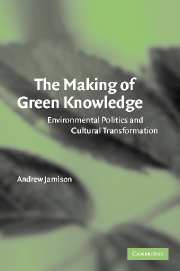Book contents
- Frontmatter
- Dedication
- Contents
- Tables
- Acknowledgments
- Introduction
- 1 On the ambiguities of greening
- 2 Social movements and knowledge-making
- 3 The dialectics of environmentalism
- 4 National shades of green
- 5 The challenge of green business
- 6 On the dilemmas of activism
- 7 Concluding reflections
- References
- Index of Names
1 - On the ambiguities of greening
Published online by Cambridge University Press: 22 September 2009
- Frontmatter
- Dedication
- Contents
- Tables
- Acknowledgments
- Introduction
- 1 On the ambiguities of greening
- 2 Social movements and knowledge-making
- 3 The dialectics of environmentalism
- 4 National shades of green
- 5 The challenge of green business
- 6 On the dilemmas of activism
- 7 Concluding reflections
- References
- Index of Names
Summary
Look at Mother Nature on the run in the 1970s …
Neil Young, “After the Gold Rush” (1970)I am struck again and again by the difficulty of designing an adequate language, an adequate conceptual apparatus to grasp the nature of the problems we seem to be faced with. I worry that last year’s conceptual tools and goals will be used to fight next year’s issues in a dynamic situation that more and more requires proactive rather than remedial action.
David Harvey, Justice, Nature and the Geography of Difference (1996: 416)From environmental protection to cultural transformations
Like women’s liberation, rock music, and the internet, an environmental consciousness can be seen to be a product of the 1960s. It was then, inspired by the spirit of the times a-changin’, and exemplified by a number of highly publicized cases of waste and pollution, that humankind’s diverse natural surroundings were seen to be in danger, and protecting the environment became a matter of public concern. As part of the counter-cultural critique of the “technocratic society” and the widespread questioning of the dominant values of the consumer culture, environmentalism emerged as a new political cause, a new historical project (Roszak 1973; Morgan 1991).
- Type
- Chapter
- Information
- The Making of Green KnowledgeEnvironmental Politics and Cultural Transformation, pp. 16 - 44Publisher: Cambridge University PressPrint publication year: 2001

